Bovine
Reproductive
Herd Health
 441-457 441-457
BOVINE THERIOGENOLOGY
Dairy
vs. Beef - click here to view a PowerPoint
Definitions:
- Several terms are routinely used in the cattle
industry and we should be familiar with their meaning: heifer,
first-calf heifer, dry cow, fresh cow, open cow, springer, "on
DHIA", heat, replacements, clean-up breeder
Reproductive performance
- The goal of any herd health program is to increase
profits and decrease the cost of production.
- One important aspect is to
increase quality herd replacements while decreasing reproductive
failures. Consequently, a decrease in reproductive culls will allow
selection for other factors, such as milk production, etc.
- Another is to monitor the reproductive efficiency
achieved and by taking action
to decrease the number of semen units used per conception (AI).
-
Number of services (or AI) per pregnant cow will reflect the
efficiency of conception and pregnancy rate when fertile cows are
mated or artificially inseminated.
- An adequate reproductive
efficiency will result in an increase production. For beef cows,
more kg calf
weaned/cow exposed to a bull will be obtained and for dairy cattle an increase in
number of days in cow's life when she is producing milk most
efficiently (see lactation curve).
Lactation curve:
- The 12 mo. calving interval is desirable
because cows that calve every 12 mo. give more milk than cows that
have a calf at longer intervals. This becomes obvious if one looks
at the lactation curve. The closer two lactations are together, the
more time is spent during peak milk production and less time during
low milk production at the end of the curve. Having cows calve once
a year (a calving interval of 12 mos., brings the curves as close
together as nature will generally allow, maximizing milk
production).
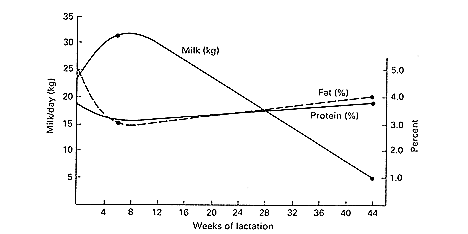
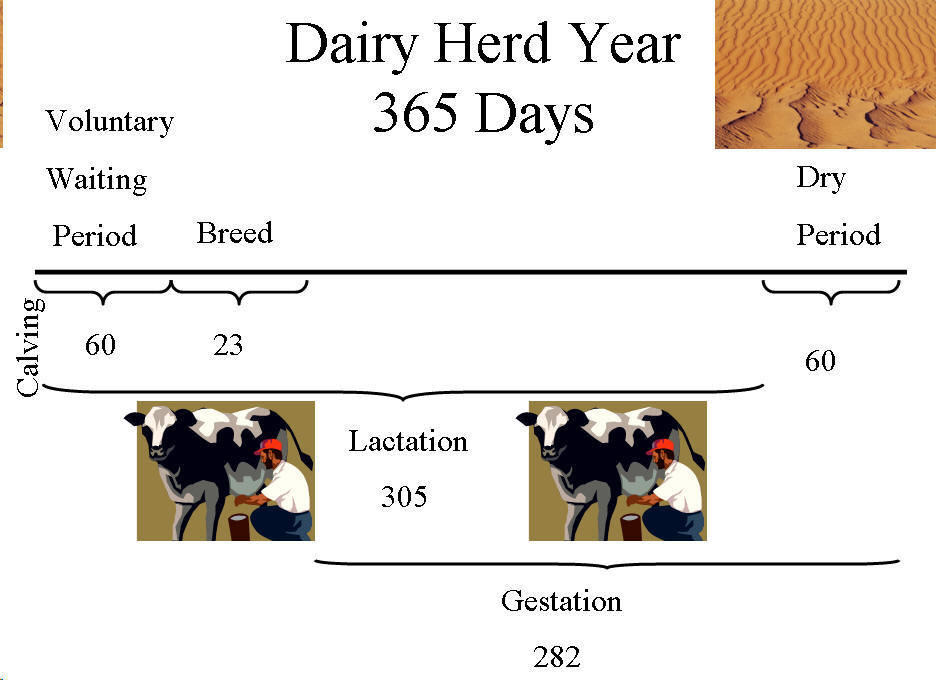
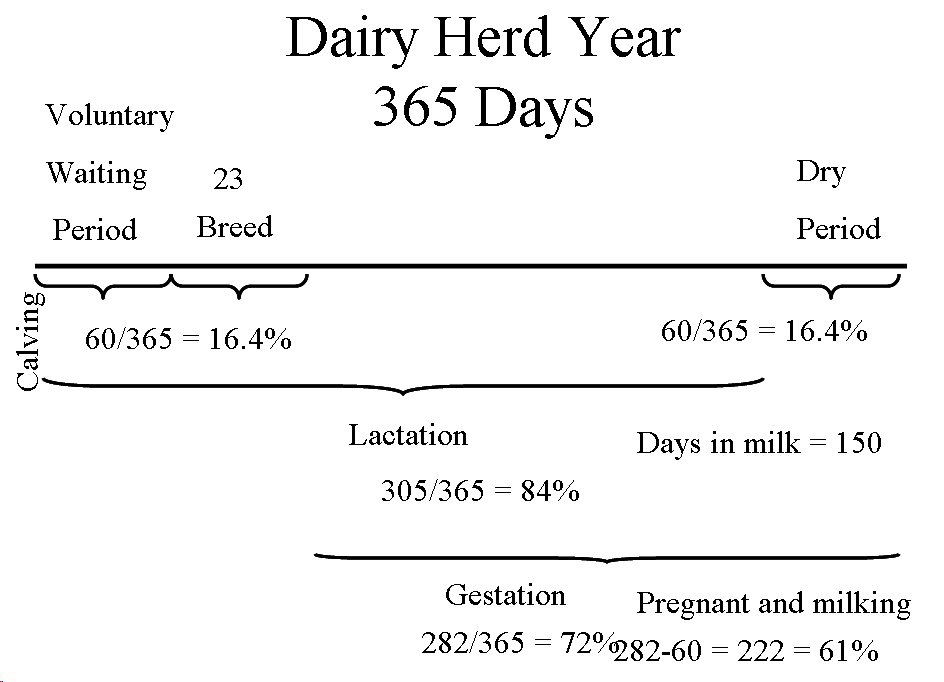
Dry period
- The dry period is a time during which the
farmer will stop milking their cows to allow the mammary tissue to
repair itself and prepare for the next lactation. It allows the cow
to have a higher peak milk production on the subsequent lactation.
The farmer stops milking the cow 45-60 days from the anticipated
calving date.
Interrelated aspects affecting
reproductive performance
- A vaccination program (JAVMA (8/1/86) is an
important aspect of herd health that affects reproductive
performance, mainly regarding diseases which cause abortions.
-
Physical facilities should minimize the deleterious effects of harsh
environmental conditions such as excessive cold, heat, humidity
while allowing comfortable conditions for reproductive events such
as estrus signs, calving, breeding practices, etc.
- Quality and
availability of replacement heifers are also important, mainly
because the goal is to have a heifer calving and lactating while she
still has not completed her total physical body growth and
maturation.
- Poor or imbalanced nutrition can be the underlying cause
for many reproductive problems such as acyclicity, delayed uterine
involution, metritis, retained placenta, abortions, etc. Body
condition scoring (Edmonson et al., J Dairy Sci, 72:70, 1989) is a
simple and efficient way to check the nutritional status in a herd.
It is graded from 1 to 5 in dairy cows and 1 to 9 in beef cows.
-
General health (parasites, feet, milk fever, ketosis, lameness,
etc.) an increase in certain problems may point to a specific area
to correct (increased abortions ->vaccination program; increase days to
first service -> heat detection; increase postpartum metritis
-> calving environment). The dry cow period should be around 45
to 60 days before the next calving to maximize best production in
the next lactation.
Client Education
- Common traits in any herd health program will
include client education, routine exams, collection and processing
of data, assessment of performance, establishment of goals,
implementation of changes to meet goals, monitoring response (set
reasonable goals and change them as they are met). Farmers must be
willing to keep records and ID cows. Adjust and set the performance
goals according to the characteristics of the farm you are working
with (dairy vs. beef, large vs small, computer availability).
Semen Quality
- Advantages of artificial insemination are often
obscured by problems such as inseminator incompetence (insemination
technique, timing of insemination, accuracy of estrus detection).
Natural breeding implies that the herd be disease free of agents
such as Trichomonas foetus,
Campylobacter spp., Brucella sp., Mycobacterium sp.).
Bulls should be checked periodically for semen quality (Breeding
Soundness Evaluation).
Beef Reproductive
ManagementPerformance
Goals
- To calve every 12 months, a cow must be bred by
83 days post calving (282 days gestation + 83 = 365)
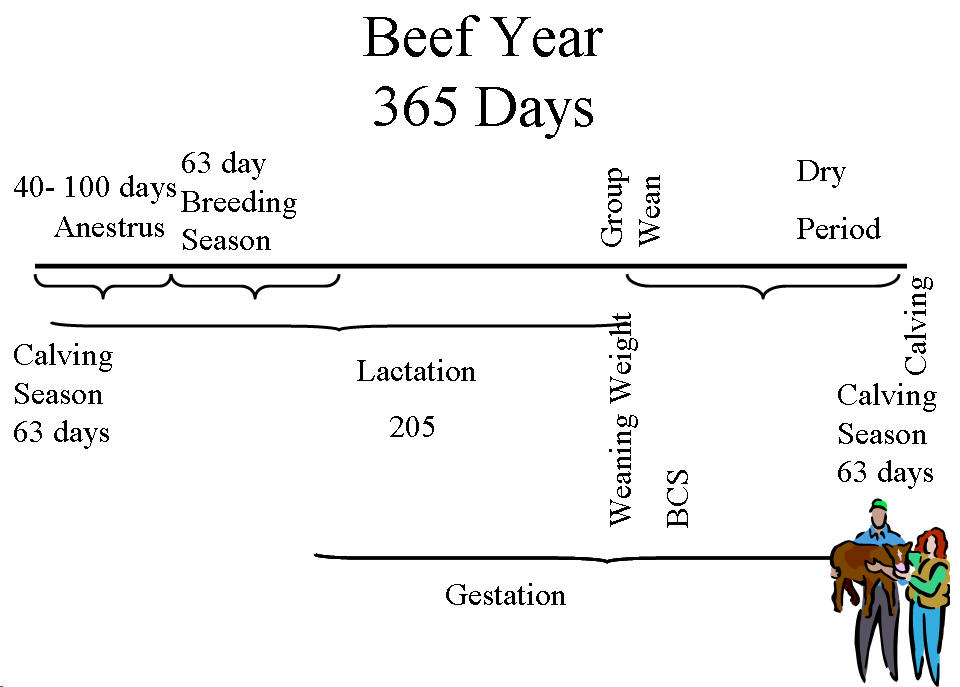
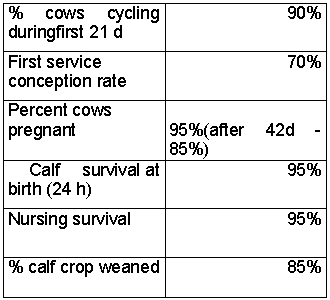
Poor Performance
- The main goal of the beef cattle producer is to produce the maximum kg calf weaned/cow exposed to a bull. This
can be affected by several factors:
- Calf mortality (dystocia, heifers with small
pelvic diameter)
- Decreased weaning weight - goal is to have a
500 lb calf at 250 days
- Decreased pregnancy rate
Acyclicity of Beef Herd
- Silent heat or anovulatory estrous cycles at
the beginning of the breeding season can be caused by inadequate
nutrition.
- Assessing body condition score is a good way to check
cows before calving.
- Cows should be fed in the last trimester of
pregnancy to calf at a body condition score 5 to 6.
- The rule of
thumb is to have cows in a good body condition before calving.
- After
calving, another alternative is to flush the cows 3 weeks before the
start of the breeding season coupled with 48 h calf removal
(suckling causes postpartum anestrus via inhibition of GnRH and
subsequently decrease pulsatile LH secretion. This hormonal
inhibition is probably modulated by endogenous opioids. The physical
presence of the calf is also important). There is a
need for good fences and a high energy calf starter.
O'Conner System:
- Moderate condition score at calving - 60 d
calving season (60 d breeding) - 48 h calf removal at start of
breeding - Cows gaining weight for 5 wks starting 2 wks before
breeding starts - Bulls of high fertility
- The importance of keeping good records can not
be overemphasized (percent calf crop, pregnancy rate, culling rates,
breeding efficiency of bulls, calf mortality, etc.).
Other
- If working with AI, utilize heat
synchronization schemes to maximize efficiency and minimize costs
- Replacement heifer management should include
periodical check on growth. You should start to breed heifers 21 d
before cows. Consequently, they will calve earlier and have longer to breed back (remember, heifers are still growing and need
more time to cycle back)
Breeding season
- The goal is to have a breeding season of 63
days (63 = 3 estrous cycles), but most people still use 90 or 120
days)
- Vaccinations
- Check the vaccination history of the herd.
Brucellosis, IBR, BVD, leptospirosis, clostridia, are recommended.
Some herds may need immunization against trichomonas and
campylobacter. Annual vaccinations should be given shortly before
the breeding season.
Testing
- Brucellosis should be checked periodically,
mainly if the farm is not in a state Brucella-free.
- Tuberculosis is
also another important disease to be tested.
- Bulls should be
negative for trichomoniasis (3 weekly cultures)
Dairy
Reproductive Management
Scheduling of visits
- Do not visit the farm every 3 weeks. Better
when done monthly, bimonthly, weekly, etc.
- When doing reproductive exams or other routine
procedures, can assess dairyman's performance in other areas, e.g.
nutrition, hoof care, heifer raising
- Tailor program to dairyman's own personal
needs. This will depend on number of cows, level of achievement of
performance goals, etc.
Records
- It is very important to keep updated records.
-
Individual cow records will allow veterinarian and farmer to decide
whether a particular cow is in trouble or not.
- Assembling records of
individual cows to give a picture of the herd as a whole serves two
purposes.
- On the one hand it makes it easier to draw up lists of
those cows which need to be brought up for herd checks, need to be
dried off, etc. - so called "action lists".
- On the other
hand they can provide the farmer with valuable measures of herd
performance. Individual cow record should include ID, date of birth,
vaccination record, breeding and heat dates, calving history (dystocia,
RFM (Retained Fetal Membranes)), mastitis, other health history,
reproductive exam information. Daily action list will include cows
to calve, breed, etc.
Vet Check List
Fresh Cows
- Cows (between 14 and 21 days post partum)
should be included in this list.
- Those cows which have been fresh
more than 21 days should have no fluid in their uterus and the
uterus should be retractable to allow thorough examination.
- If a cow's uterus
is involuting behind schedule, or abnormal post partum, we will find
her on this check.
- We do not routinely perform post partum checks
earlier than three weeks since a normal cow would still have an
enlarged uterus and maybe some fluid at that time, and it would be
difficult to identify a cow with a problem.
- Fresh cows found to be
undergoing an abnormal uterine involution will suggest you to check
calving area, calving practices, dry cow nutrition, etc.
- High calf
mortality also suggest you check on calving practices.
Problem Cows
- Cows with more than 3 services are also in the
vet check list. Uterine or ovarian pathology should be ruled by
gynecological exam. Abnormal cycles, discharges, should be
investigated.
- Heat detection problems
- Cows found open and not rebred in the next 21
days reveal a heat detection problem if reproductive tract is
normal. Cows without recorded heat after 21 days past the voluntary
wait period suggest the same problem.
Pregnancy Exams
- This list should include all cows bred >35
days and not seen in heat.
- You can also recheck all pregnant cows
seen in heat or with abnormal discharge or pregnant cows before the
dry period to make sure they are still pregnant.
- Because roughly 1
in 10 cows will loose a pregnancy before day 90 a recheck can be
scheduled for this time.
Heat Detection
- Heat detection is the foundation for a successful reproductive
program.
- A good heat detection rate, requires all cows have an
identifiable ID.
- A good plan for a heat detection program must
include post partum and pre-breeding checks.
- Heat detection can be
labor intensive and requires time, knowledge and motivation (some
farms have an incentive program).
- All cows should be sound and be
comfortably housed ( remember the effects of nutrition, lameness,
heat stress, etc.)
Performance Goals
General
- From Dairy Herd Improvement Assoc. (DHIA)
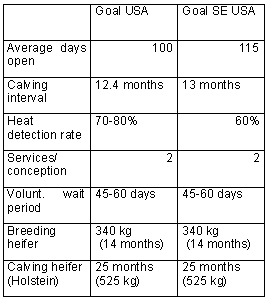
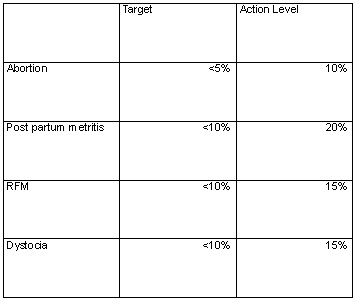
Estrus Detection
Estrus Signs
Cow
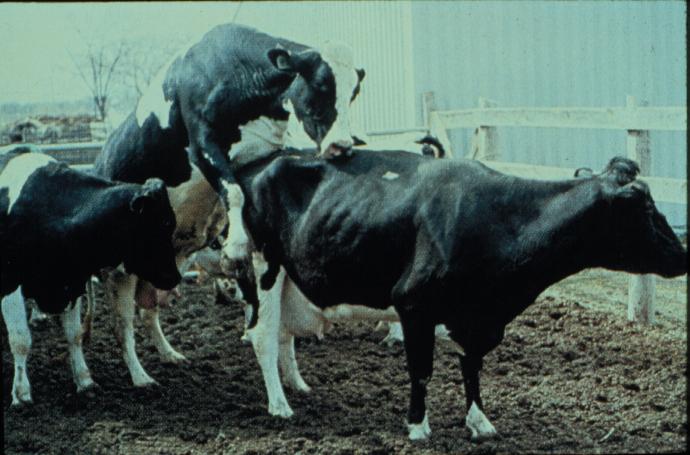
- Searching
- Increased locomotion, vocalization, and tail
movements
- Courtship
- Increased grooming, mounting attempts with
other females
- Arousal
- Homosexual behavior and bull receptivity
Bull
- Search
- Chin resting, testing for lordosis
- Courtship
- Flehmen, nuzzling and exploring perineal region
- Arousal
- Penile protusion with dribbling of seminal
fluid with few spermatozoa, erection and copulation
Other
- Swollen vulva; clear vaginal discharge (mucus)
; roughened tailhead; pink vaginal mucosa. After estrus (1-3 days),
50% will have a bloody discharge (metestrous bleeding)
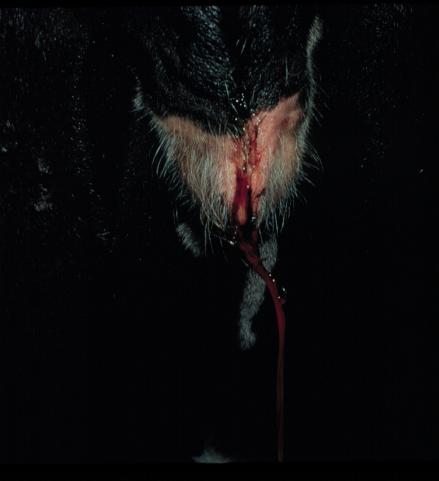
Artificial insemination timing
- LH surge occurs at the beginning of estrus and
will cause ovulation 24 to 30 h later.
- Average estrus lasts 14 - 18
h. It is shorter in beef than in dairy cows.
- Cows should be
inseminated in the last 2/3 of estrus up to 6-8 h after standing
heat.
- The a.m./p.m. rule is a good and practical way to manage
artificial inseminations.
- If a cow is seen in heat in the morning,
she will be scheduled for insemination in the evening and
vice-versa.
- Mature, ovulated oocytes hold good fertility only for
10-12 hours.
Methods of Heat Detection
Observation
- It is the best but is labor intensive,
time-consuming, and boring.
- Cows need to checked 30 minutes every 12
h.
- Only 25-30% will show standing heat in 2 consecutive periods of
heat checking.
- Good footing surface is essential for a good heat
behavior display.
- In the summer time, mainly here in the S.E. U.S.,
many cows will show heat between 12 a.m. and 6 a.m.
Estrus Detection Aids
- Estrus-detector animals are very useful to
enhance heat detection and include vasectomized bulls, surgically
altered bulls or hormonally treated animals (males or females).
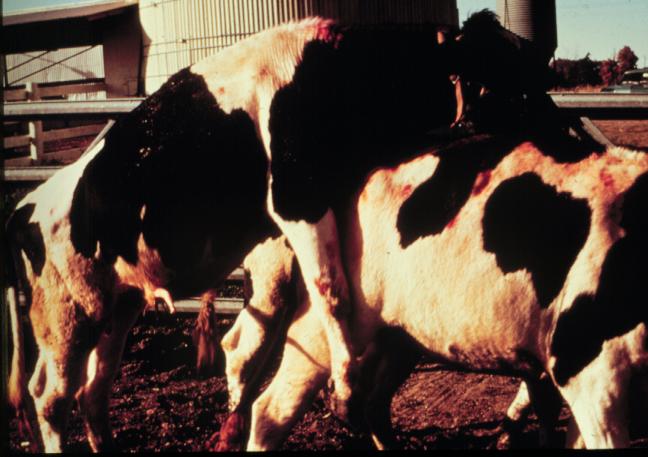
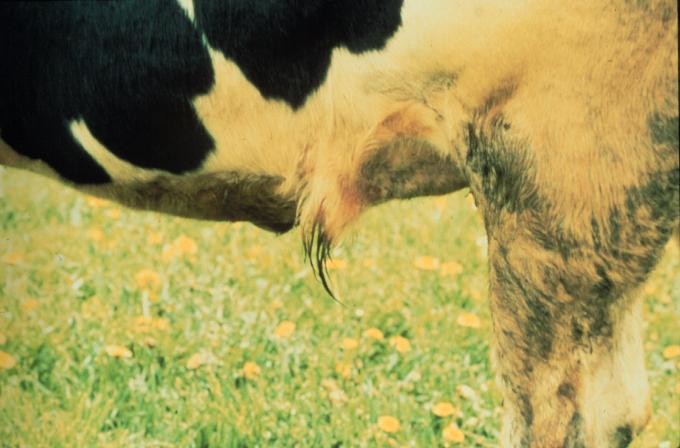
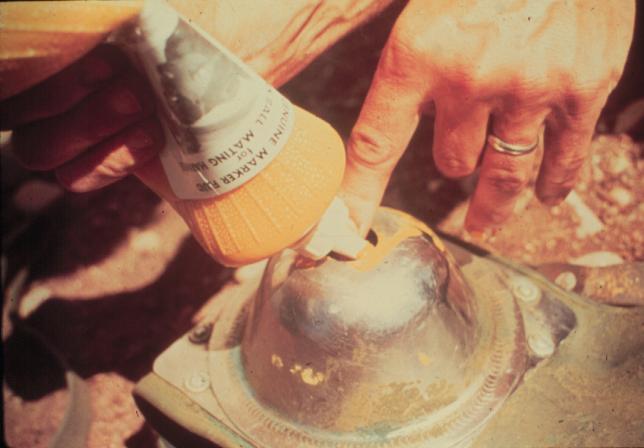
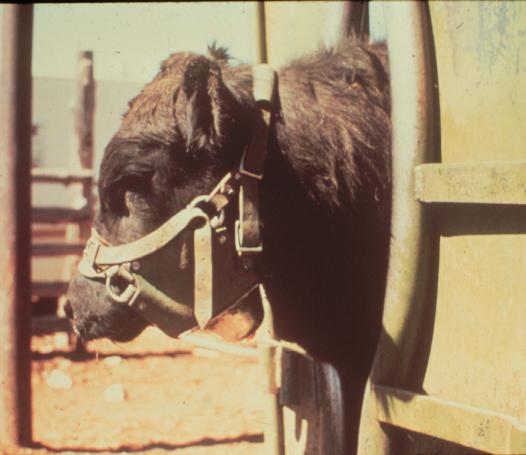
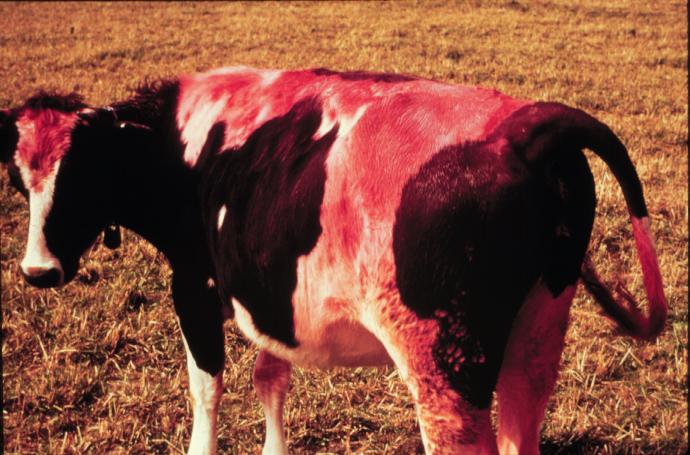
- Pressure-sensitive mount detectors
- Mount detectors applied with adhesive in the
cow's rump. They will be activated by sustained pressure caused by
the mounting (example = Kamar). Problem with false positives.
Remember to write cow's ID on cloth.
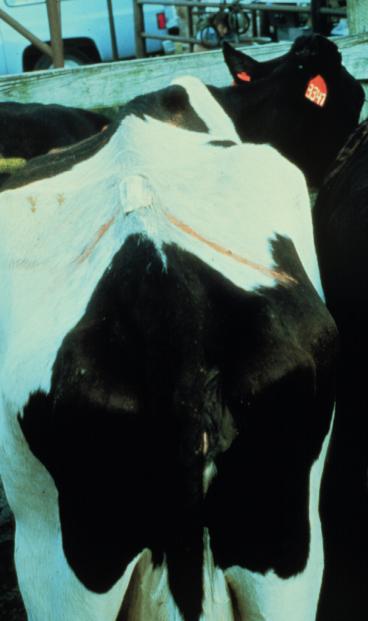


-
Chalking/Painting the tailhead is
another inexpensive option.
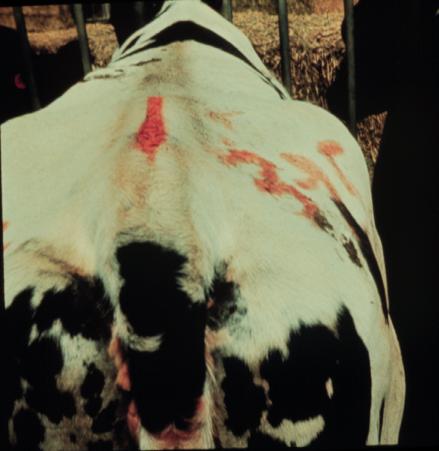 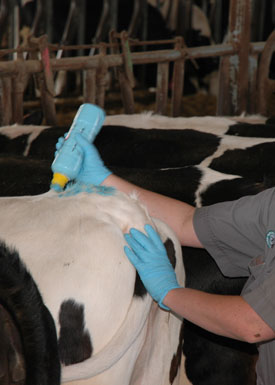 
-
Electrical resistance of reproductive tissue
fluids
-
Electrical resistance is decreased during
proestrus and estrus. Extremely labor intensive.
-
 
-
Pedometers register increased walking times
-
Electronic pressure-sensitive mount detectors
- Heat Watch
-
Very efficient
-
Duration and
number of mountings are
transmitted to a receiver interfaced with a computer.
-

-
Rectal palpation
-
Sensitivity and Specificity of Rectal Palpation to
Determine the Presence of a
Mature Corpus Luteum in Cycling Cows
|
|
Corpus Luteum Present
|
|
|
Palpate
Corpus Luteum
|
Yes
|
No
|
Totals
|
|
Yes
|
8
|
5
|
13 |
|
No
|
2
|
6
|
8 |
|
Totals
|
10 |
11 |
21 |
-
Milk progesterone
-
Dogs

Assessing
heat
detection
efficiency
- Percent pregnant at pregnancy check - >
90%
- 24 day heat detection trials
- Average estrous cycle length - closer to
21
- Ratio of single to double heats (>6:1)
|



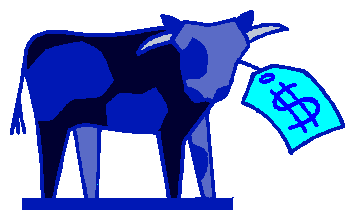 Bovine
Index
Bovine
Index













